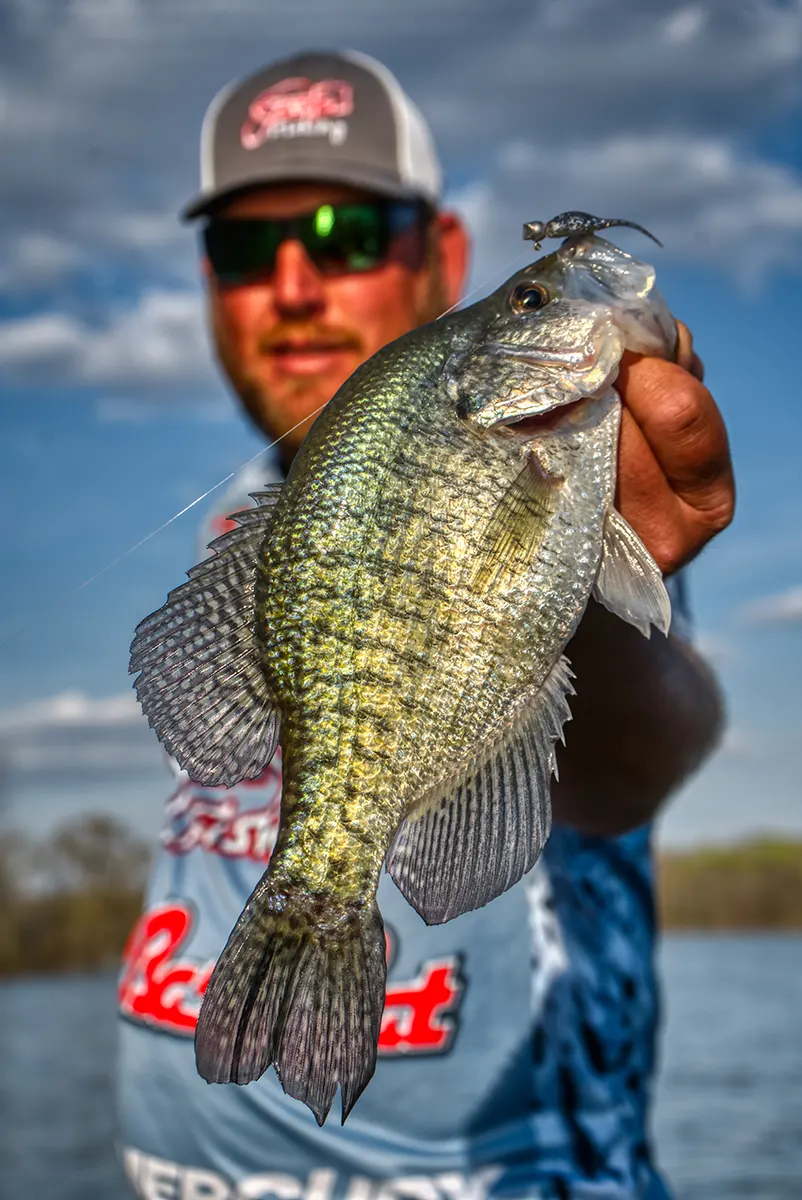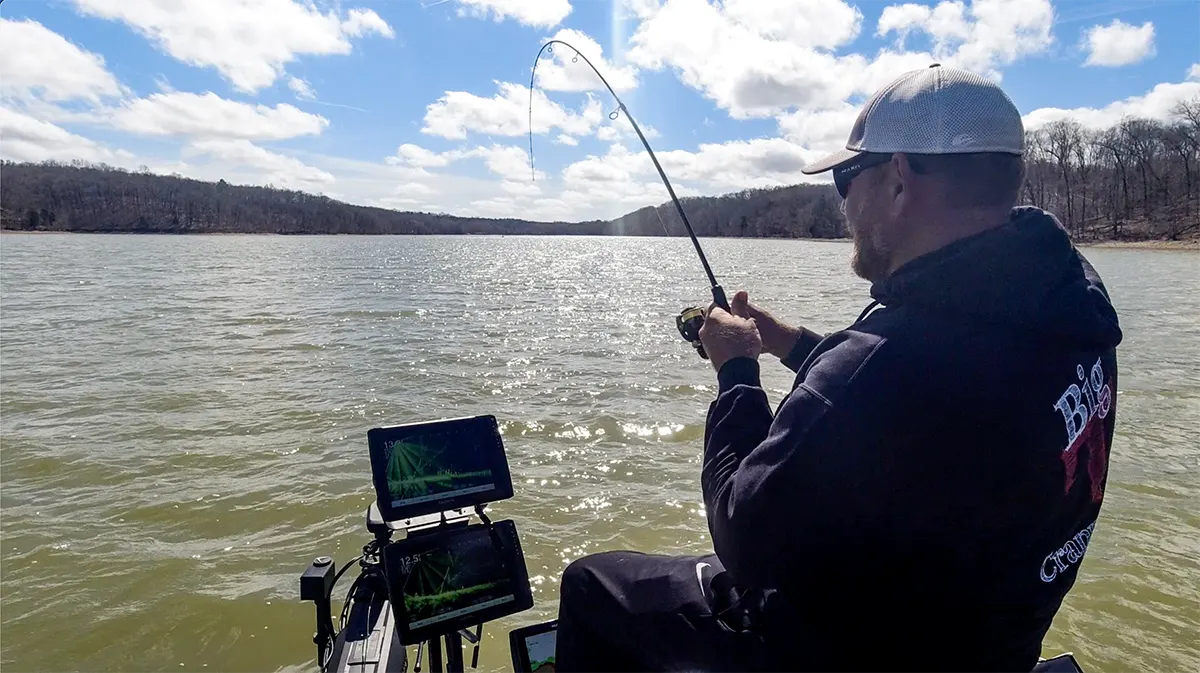Warning: Undefined variable $k in /home/nginx/domains/wired2fishcom.bigscoots-staging.com/public/wp-content/themes/understrap-child-0.6.0/functions.php on line 984
Warning: Undefined variable $k in /home/nginx/domains/wired2fishcom.bigscoots-staging.com/public/wp-content/themes/understrap-child-0.6.0/functions.php on line 987
Spring crappie fishing in something many anglers look forward to every year. And knowing ahead of time that crappie move more this time of year than maybe any other time of year is part of understanding how to consistently catch them during the spring migration.
Essentially crappie are going to move from their wintering holes to their shallow spawning areas and back out again all in the span of a couple to three months. Sure some of your larger creek arms have year round populations of crappie or resident fish. But a big wave of fish come from the main lake and return to the main lake. And understanding this can put you around a lot more crappie at the right times during spring fishing.
We went through the basics of the spring crappie migration with professional crappie world champion angler and crappie lure designer Tony Sheppard who has spent the better part of 3 decades chasing crappie around on his home waters of Kentucky and Barkley Lake as well as crappie all over the country. And he shared his experiences with how crappie behave in the spring to help you catch a lot more crappie.
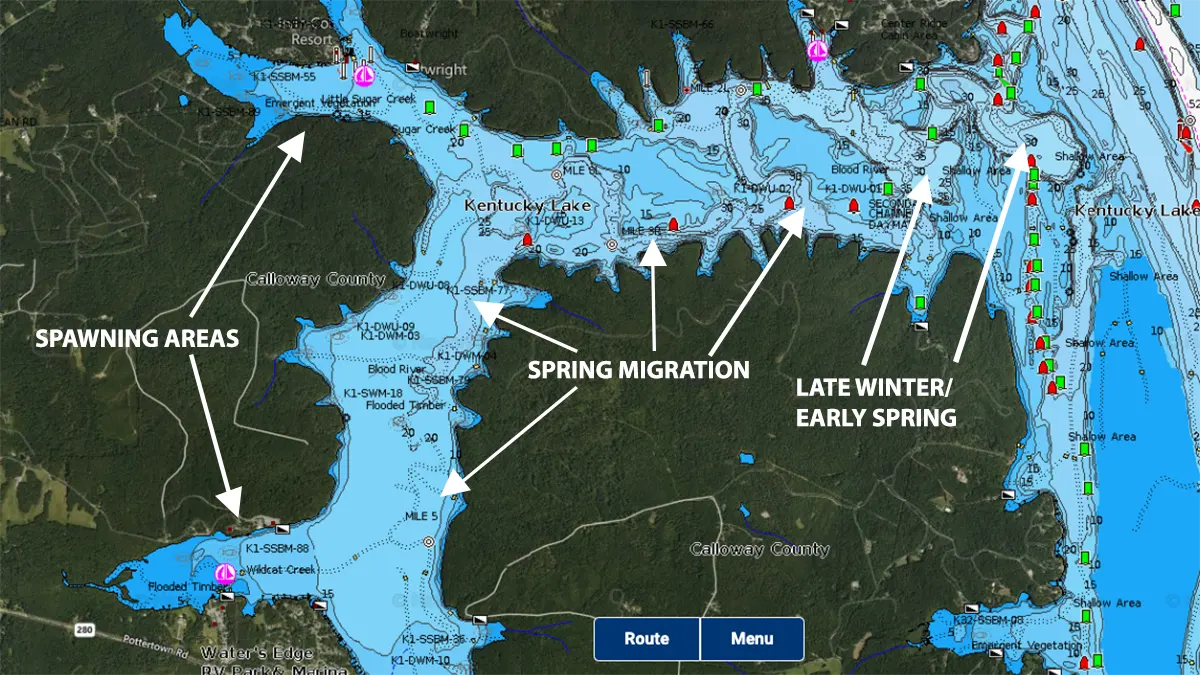
SPRING MIGRATION BASICS
Here today, gone tomorrow. That’s the story of crappie in the spring. Especially early. Once they get to their spawning areas, they might stay put for a few days and along each stop along the way they may be there for a few days to a week. But from week to week and month to month, they are moving even just a few hundred yards as they migrate to and from spawning areas.
Deep winter haunts to dirt shallow beds
Most crappie will stay where the water is the most comfortable. That probably goes for any game fish. So when frigid winter temps cool the surface, the crappie will retreat to deep water out in the mouths of major creeks or the main lake itself. Hanging out on deep cover and structure waiting for the weather to break to start feeding up and heading to spawning grounds.
So Sheppard has spent a lot of time learning where crappie go in the winter and where they spawn in the spring and then it’s just a hunting game from week to week to figure out where in the migration they are.
“I fish a lot of different depths every time I fish,” Sheppard said. “You can always catch some crappie shallow and some crappie deep, but when you’re looking for the better crappie, when you find bigger crappie at a certain depth or a certain section, chances are you will start finding a lot more at that same type of location.”
While, in early prespawn he might catch big crappie consistently in 18-20 feet of water, by the the time they move in to spawn he might be in 2-6 feet of water depending on the season and weather patterns.
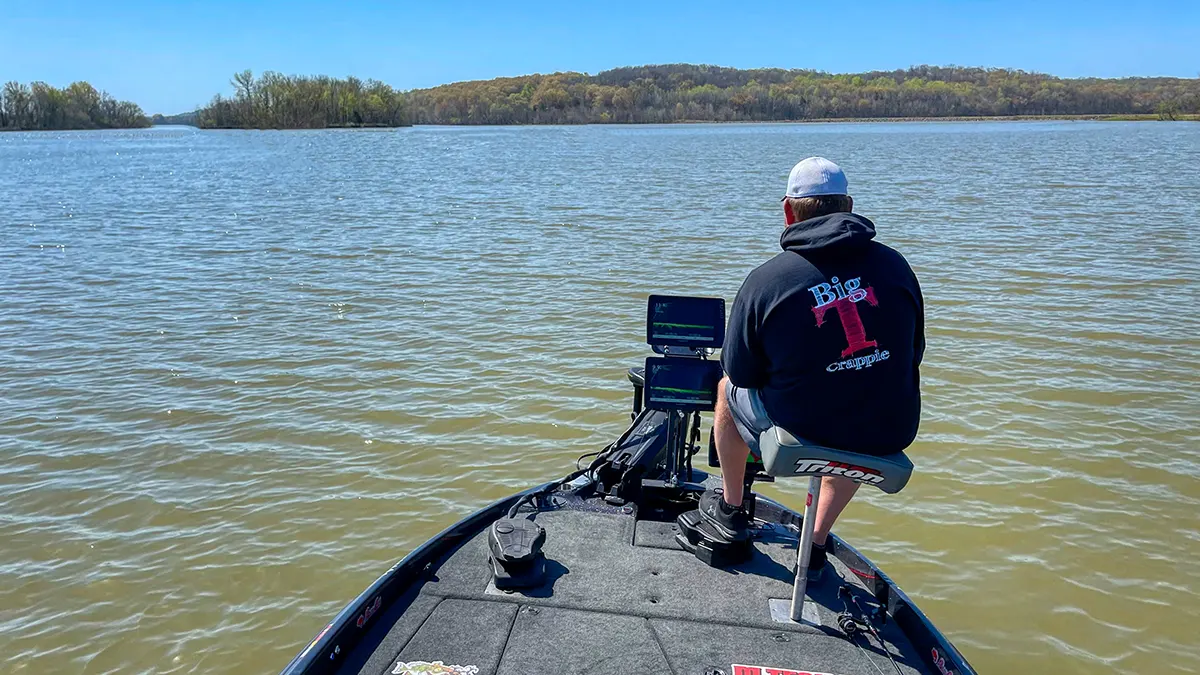
HOW TO TARGET CRAPPIE AS THEY MOVE IN THE SPRING
There is no denying that crappie are moody fish. Some days they knock your jig out of the park before it even gets close to the cover. And some days they ignore it for 20 straight casts. So they can test your patience in the spring. Between moving and their mood around the spawn, finding them is more than just knowing a spot.
It’s a mood thing
Early in the spring crappie will start moving up in the water column, sunning, roaming and feeding to get ready for the spring spawn. They will often be aggressive and big and not relating to much of anything other than maybe bait or the warmth of the sun. Then later in the spawn, they are guarding their nests and their fry and keeping everything away. Usually thought, they are not so worried about necessarily eating. So it can make catching a little trickier.
It’s a depth thing
Depth is really relative in the spring. A fish might only be 4 feet deep but suspending over 20 feet of water early on and then laying with their bellies in the mud in 2 feet of water later on near the spawn. Open water sniping is popular in the early spring and then finding shallow cover is popular when they move in to spawn.
But shallow is relative. If there is tons of good looking water 2 to 4 feet deep but all the cover is in 6 to 8 feet, then they might only spawn in 6 to 8 feet of water. Or they might spawn in a foot of water if there is a lot of water color and good bottom and cover at that depth. It just depends on where you are fishing, water levels, and what’s available to the crappie to spawn.
BEST TECHNIQUES
Sheppard is a versatile crappie angler. He was an accomplished spider rigger and can long pole them with a jigging rod. These days he’s an accomplished caster. Between Jenko Trick Stick Light spinning rods and Jenko Double Down BFS rods for crappie, he’s often staying off of the fish and getting them to react from a distance.
Here’s a few of his most popular ways to catch crappie in the spring.
Casting open water sunners
When the crappie first start moving out of their deep haunts he has found that many will be high in the water column sunning over deep water and he will take a 1/16-ounce jig and cast to those fish. Because the water is still pretty cool, the fish don’t always bite on the initial cast.
“I will make multiple casts to a fish and just try to slow the jig down when I get close to the fish so it has a second to react,” Sheppard said.
Long poling brush stagers
When the fish move in and start staging on mid-depth cover, Sheppard will continue to cast to them but often finds you have to get a jig rod out. He really holds the jig still around those crappie that don’t seem to want to chase to coax them into biting on shallow cover. And slowly raise the jig up to get a fish to move and bite.
Corking shallow spawners
When the crappie get shallower than 6 feet, and are about to or are actually spawning or guarding, he will add a spring bobber to his jig. This way he can move the jig slowly over the fish and keep it in their strike zone a long time.
“I love to cork them in the spring,” Sheppard said. “They will surprise you how shallow they get. With a bobber, you can fish really shallow but still move the jig really slow using the bobber to keep it off the bottom and out of cover.”
Sheppard prefers the spring pinch on bobbers over slip corks with bobber stops.
“I like the spring loaded king because, a crappie sometimes takes the jig and just lifts up slightly,” Sheppard said. “You don’t always see that subtle change on a slip bobber where the pinched on bobber, lays right over. I am just looking for the slightest little change in my bobber either under the water or laying over.”
Plus this stump might be 2 feet tall in 4 feet of water but the next one is 1 foot tall in 6 feet of water. So you have to continually adjust and it’s quick and easy with the spring lock bobber. We’re working on a video to show you how fun it is to cork crappie.
Casting / pushing jigs in deeper cover
After the spawn finishes up, Sheppard will migrate out with the crappie fishing a little deeper cover as the fish move out to recover and get ready to move back to deep water or the main lake. This can be some good crappie fishing and often when a lot of crappie anglers have given it up for the spring. Sheppard is a 12-month out of the year crappie angler so he’s always following the fish and learning a little more every year.
He will cast his jigs over deeper cover to catch most of his crappie in the late part of spring. Sometimes the jig rod is handy for finicky recouping crappie. He will drop the jig down and push it up to the pile slowly and get those lockjaw crappie to bite.
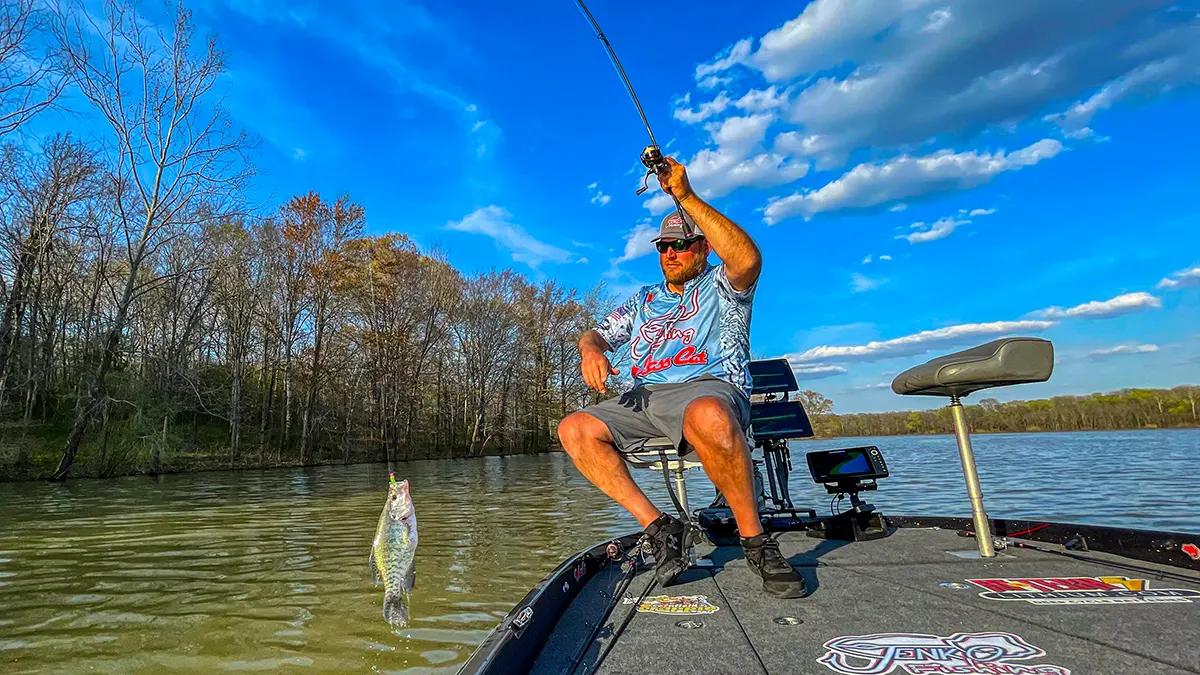
BEST LURES FOR SPRING CRAPPIE
A crappie jig will get some crappie to bite most of the time. There are times where certain jigs and profiles and actions work best though, even in the spring.
Hair jigs early and late
When the water is still relatively cold in the early spring, a hair jig is your friend. Sheppard uses a variety of hair jigs but most of the time he’s using Jenko’s hair jigs or custom tied jigs from a friend Greg Davis who goes by Crappie G on Facebook. He mostly sticks with 1/16 ounce but will go to 1/32 ounce in calm conditions and with finicky crappie.
Swimmers in the middle
When the fish start actively feeding and migrating shallower before the spawn, likes a plastic and jighead that has some kick. He will often use the Jenko Tickle Fry and cast to crappie from a distance. He targets mid-depth cover between 6-12 feet.
Get small for spawners
When he moves in shallow during the spawn, he’ll put a small jig under a cork and keep it natural. Natural profiles like the Jenko Baby Shad and natural colors if the water is clear or something like pepper dew when the water has some color to it.
Go big in the post
After the crappie get done spawning, Sheppard will go back to full sized jigs and even bigger jigs like the fry daddy for those fish that go on the feed to get back to full strength after the spawn. Crappie expend a lot of energy spawning and guarding nests and fry so in the post spawn, they will take a bigger meal.
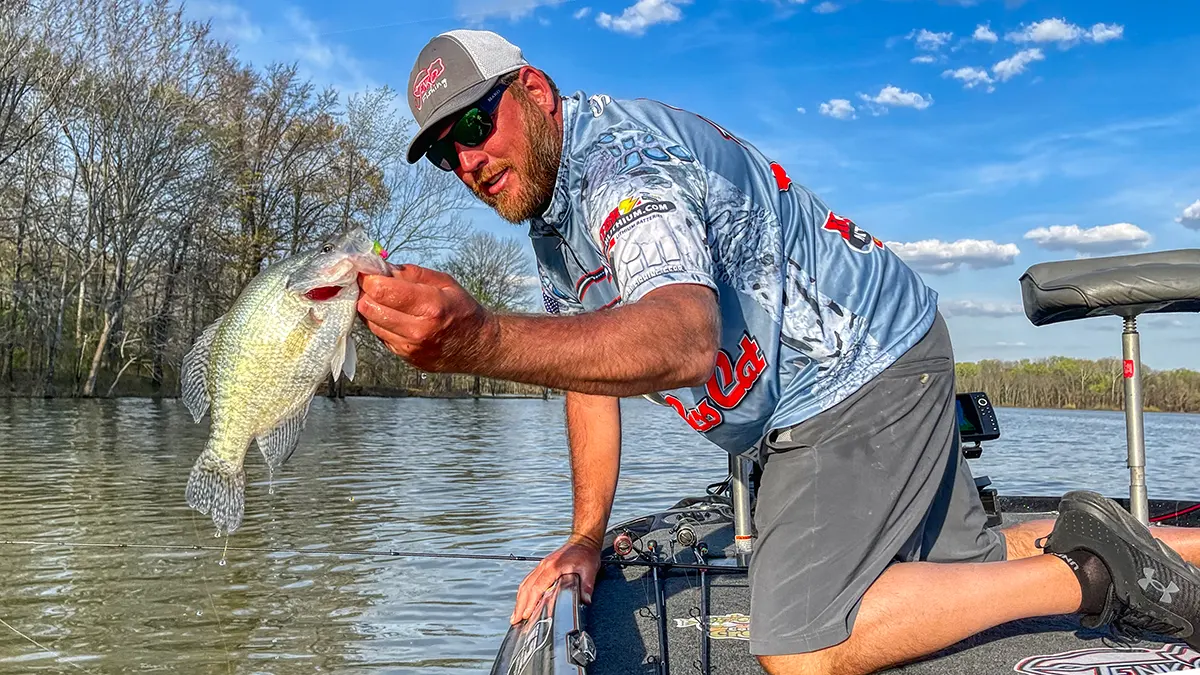
WRAPPING IT ALL UP
Fish have fins. They don’t sit in one place all month. And in the spring, you’re lucky to find them in one place for more than a week. They are migrating in and out all the time. Fish are coming in to spawn while others are moving out after being done with the spawn. So working your way back and forth from deep to shallow and testing several areas is the best way to hone in on the depth and stage the crappie are in during the spring migration.
On a recent trip with Sheppard, he was able to go from 8-12 feet, then to 2-6 feet then in that 5-9 foot range where he determined most of the fish were setup. And he was able to make his fishing more consistent for big fish and more active fish once he honed in on what part of the creek the fish were using, what depth they were in their migration and their mood. It’s a simple application that should help a lot of crappie anglers stay on the crappie in the spring.
